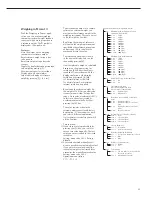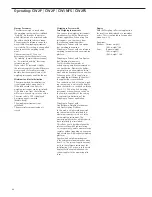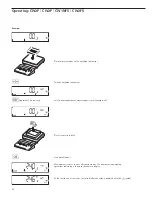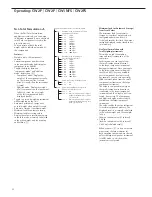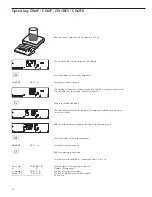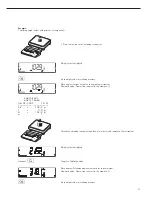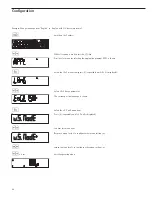
Averaging
(Animal Weighing)
V
With the Averaging application, you
can use your weighing instrument
for calculating weights as the average
of a number of individual weighing
operations. These individual operations
are also known as “subweighing
operations."
This function is used to determine
weights under unstable ambient
conditions or for weighing unstable
samples (such as live animals).
Features:
– Averaging started manually or
automatically
– Press the
r
key to select the desired
number of subweighing operations
– Toggle the display between last result
and current weight by pressing
w
A number of subweighing operations
are required to form the basis for
calculation of an average weight. These
are performed consecutively as soon as
the weight of one sample differs from
that of the previous sample by less than
the preset deviation.
The value for this deviation is entered
in the Application settings (3.19) as
a percentage. This value and the mini-
mum load must be reached to start
the averaging routine.
Whether averaging starts automatically
or manually is defined under menu
item 3.18.
There are four modes for calculating
average weights:
– Manual start with preset number
of subweighing operations
To use this mode, place the sample
or animal on the weighing instrument
and press
O
.
– Manual start with the number of sub-
weighing operations entered manually
To use this mode, place the sample/
animal on the weighing instrument,
press
r
to enter the number of sub-
weighing operations (10, 20, 30, 40)
and then press
O
.
– Automatic start with preset number
of subweighing operations
The subweighing operations begin
when the weight of the sample/animal
on the weighing instrument exceeds
the minimum load.
49
– Automatic start with the number
of subweighing operations entered
manually
To use this mode, press
r
and enter
the number of subweighing operations
before placing the sample or animal
on the weighing instrument. The
subweighing operations begin when
the weight of the sample/animal on
the weighing instrument exceeds the
minimum load.
If the “automatic tare" function is con-
figured, the weight of the first load is
stored as the tare value, and averaging
begins only when the second load
is placed on the weighing instrument
(provided this weight exceeds the
preset minimum load).
Minimum Load for Automatic Start
The minimum load for automatic start
is configured under menu item 3.6.
If the load exceeds this limit, the aver-
aging routine can begin.
Display
A calculated average value is shown
continuously on the main display.
The symbol
!
is displayed.
Press
w
to toggle the display between
this result and the current weight value.
If the menu setting “Display is static
until unload threshold reached" (3.21.1)
is active, the program returns to the
weight display automatically when the
weighing instrument is unloaded; i.e.,
when the load is less than half the mini-
mum load. The result of the most recent
averaging operation is not stored.
If the menu setting “Display is static
until
c
is pressed" (3.21.2) is active,
the average weight remains on the
weight display after the weighing
instrument is unloaded, until the
c
key is pressed or until a new measure-
ment series is started, whether manually
or automatically.
– Tare function:
1) If you store a tare (weight value) by
pressing the
)
key, you can later
enter a tare value manually. The tare
value you enter is added to the stored
tare value.
Setting: menu code 3.25.1 (factory
default)
2) A tare value entered manually over-
writes a stored tare value (weight value).
If you enter a tare value manually, a
tare value (weight value) stored later
overwrites the manually entered value.
Setting: menu code 3.25.2
Operating menu setting:
APPL
:
V
:
3.25.
Application Parameters: Averaging (Animal Weighing)
3. 5.
Minimum Load for Automatic Taring
and Automatic Printing
3. 5. 1 * 1 digit
3. 5. 2
2 digits
3. 5. 3
5 digits
3. 5. 4
10 digits
3. 5. 5
20 digits
3. 5. 6
50 digits
3. 5. 7
100 digits
3. 5. 8
200 digits
3. 5. 9
500 digits
3. 5.10
1000 digits
3. 6.
Minimum Load
3. 6. 1 * 1 digit
3. 6. 2
2 digits
3. 6. 3
5 digits
3. 6. 4
10 digits
3. 6. 5
20 digits
3. 6. 6
50 digits
3. 6. 7
100 digits
3. 6. 8
200 digits
3. 6. 9
500 digits
3. 6.10
1000 digits
3. 7.
Automatic Taring: 1st Weight Tared
3. 7. 1 * Off
3. 7. 2
On
3. 8.
Start Application with Most Recent
Application Data when Combics
is Switched On
3. 8. 1
Automatic (on)
3. 8. 2 * Manual (off)
3.18.
Start of Averaging Routine
3.18. 1* Manual
3.18. 2
Automatic
3.19. Animal
Activity
3.19. 1
0.1 % of the animal/object
3.19. 2* 0.2% of the animal/object
3.19. 3
0.5 % of the animal/object
3.19. 4
1% of the animal/object
3.19. 5
2% of the animal/object
3.19. 6
5% of the animal/object
3.19. 7
10% of the animal/object
3.19. 8
20% of the animal/object
3.19. 9
50% of the animal/object
3.19.10
100 % of the animal/object
3.20.
Automatic Printout of Results
3.20. 1* Off
3.20. 2
On
3.21.
Static Display After Load Removed
3.21. 1* Display is static until unload
threshold reached
3.21. 2
Display is static until
c
is
pressed
3.25. Tare
function
3.25. 1* The tare value entered is added to
the stored tare value
3.25. 2
Overwritable tare value
Содержание CH1NE
Страница 102: ...CH Platform Dimensions Scale Drawings CH G CH E 102 ...
Страница 108: ...108 ...
Страница 109: ...109 ...
Страница 110: ...110 ...
Страница 111: ...111 ...
Страница 112: ...112 ...
Страница 113: ...113 ...
Страница 114: ...114 ...
Страница 115: ...115 ...
Страница 116: ...116 ...
Страница 117: ...117 ...
Страница 118: ...118 ...
Страница 120: ......











